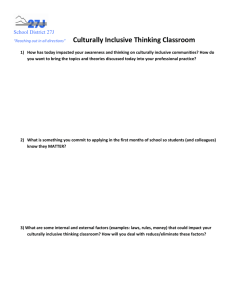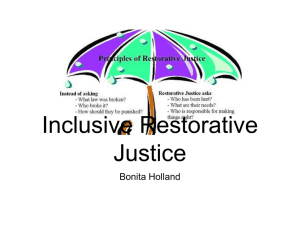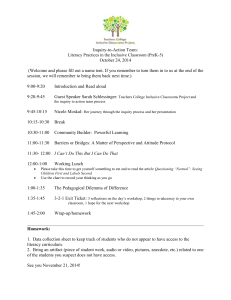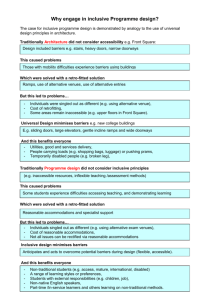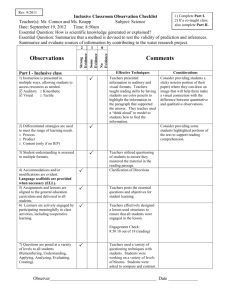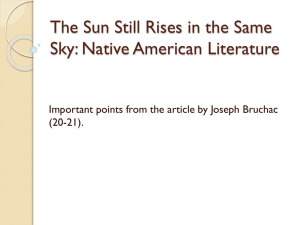4.1.2 The Inclusive Design Cube
advertisement
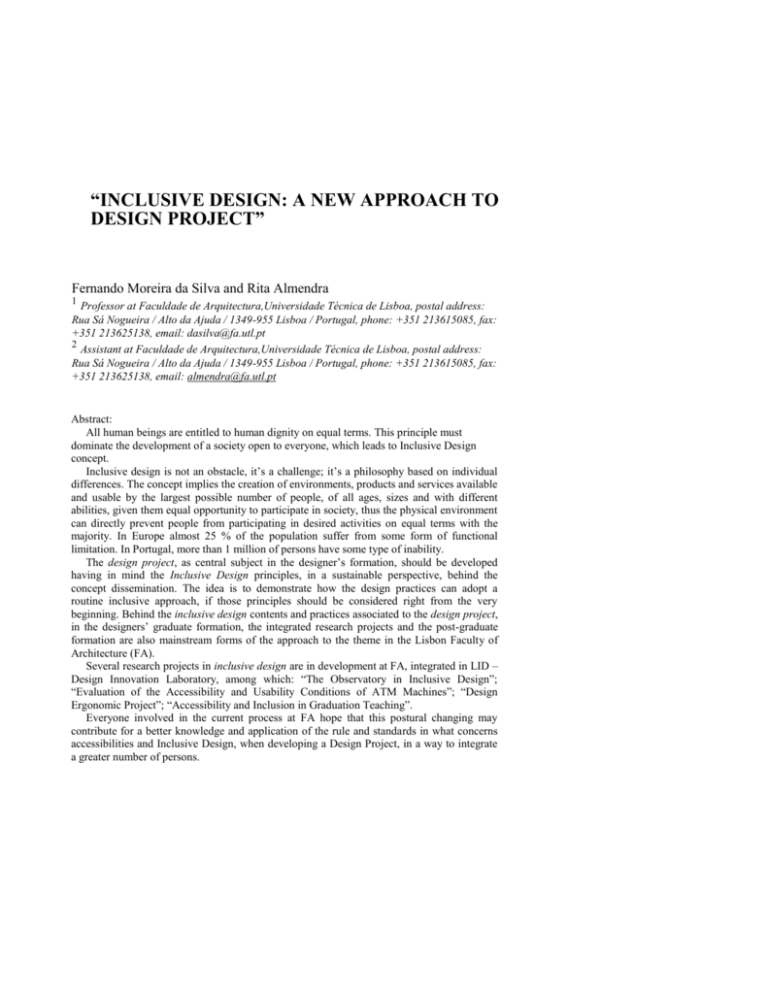
“INCLUSIVE DESIGN: A NEW APPROACH TO DESIGN PROJECT” Fernando Moreira da Silva and Rita Almendra 1 Professor at Faculdade de Arquitectura,Universidade Técnica de Lisboa, postal address: Rua Sá Nogueira / Alto da Ajuda / 1349-955 Lisboa / Portugal, phone: +351 213615085, fax: +351 213625138, email: dasilva@fa.utl.pt 2 Assistant at Faculdade de Arquitectura,Universidade Técnica de Lisboa, postal address: Rua Sá Nogueira / Alto da Ajuda / 1349-955 Lisboa / Portugal, phone: +351 213615085, fax: +351 213625138, email: almendra@fa.utl.pt Abstract: All human beings are entitled to human dignity on equal terms. This principle must dominate the development of a society open to everyone, which leads to Inclusive Design concept. Inclusive design is not an obstacle, it’s a challenge; it’s a philosophy based on individual differences. The concept implies the creation of environments, products and services available and usable by the largest possible number of people, of all ages, sizes and with different abilities, given them equal opportunity to participate in society, thus the physical environment can directly prevent people from participating in desired activities on equal terms with the majority. In Europe almost 25 % of the population suffer from some form of functional limitation. In Portugal, more than 1 million of persons have some type of inability. The design project, as central subject in the designer’s formation, should be developed having in mind the Inclusive Design principles, in a sustainable perspective, behind the concept dissemination. The idea is to demonstrate how the design practices can adopt a routine inclusive approach, if those principles should be considered right from the very beginning. Behind the inclusive design contents and practices associated to the design project, in the designers’ graduate formation, the integrated research projects and the post-graduate formation are also mainstream forms of the approach to the theme in the Lisbon Faculty of Architecture (FA). Several research projects in inclusive design are in development at FA, integrated in LID – Design Innovation Laboratory, among which: “The Observatory in Inclusive Design”; “Evaluation of the Accessibility and Usability Conditions of ATM Machines”; “Design Ergonomic Project”; “Accessibility and Inclusion in Graduation Teaching”. Everyone involved in the current process at FA hope that this postural changing may contribute for a better knowledge and application of the rule and standards in what concerns accessibilities and Inclusive Design, when developing a Design Project, in a way to integrate a greater number of persons. 2 Fernando Moreira da Silva and Rita Almendra We should be able to make our choices about spaces, environment, objects and information design, and also its politics, not only to reduce the barriers, but also to incorporate all in a sustainable approach, with social responsibility and respect for the human rights. Key words: Inclusive design, Universal Design, Design For All, Product design, Identity, Stigmatization, Satisfactory products, Denotation, Connotation. 1. WHAT IS INCLUSIVE DESIGN, UNIVERSAL DESIGN AND DESIGN FOR ALL Inclusive Design shares a similar origin as well as identical objectives of other design approaches or denominations, such as: “universal design”, “design for all”, “lifespan design” and “design for the diversity”. The origin of the term is North American and begin to be developed after the worries with the disabilities, having assumed later on amore overall position and meaning, assuming nowadays the definition of projecting for all. Formally the concept supports itself in the “Seven Principles of Universal Design” [1], developed by a group of researchers formed by architects, product designers, engineers, and environment designers. Inclusive Design is not an obstacle, it’s a challenge! It’s a philosophy based on individual differences. Inclusive Design is a philosophy which is materialized in design project processes whose result is the creation of products, services and/or environments available and usable by the largest possible number of people, regardless of age, gender or abilities. The aim of the concept is to make life easier for everyone by making products, means of communication, buildings and urban environments, which are more useable for more people at little or no extra cost (adapted from Shipley 2002) [2]. It is a complex and evolutive concept which tries to answer not only the above questions as well as the ethnic questions, economic resources, education, culture, etc. Inclusive Design, or Universal Design, or Design For All, is an overall strategy and philosophy which is based on giving all people equal opportunities to participate in modern society. This means that our physical surroundings, products and services are planned and designed so that everyone can participate regardless of age or physical ability. All human beings are entitled to human dignity on equal terms. This principle must dominate the development of a society open to everyone, which leads to Inclusive Design concept. However, the physical surroundings also contribute to the creation of physical barriers – e.g. when wheel-chair users, persons with walking Inclusive Design: a new approach to Design Project 3 difficulties, people pushing prams or senior citizens cannot climb the steps to a shop or an office or a mean of transportation and where there is no elevator or any other alternative. We must not forget that these people are active agents of their own will. The physical environment can directly prevent people from participating in desired activities on equal terms with the majority. The physical environment covers many things: In addition to buildings and product design, sign-posting, colour selection, transport and IT are also areas where Inclusive Design is of the utmost importance. An environment filled with obstacles or lacking of facilitators will reduce performance, while other environments, fitted with facilitators, will allow improving performance. Inclusive Design doesn’t start only with the aspiration of designing for all, but especially with a critic look over the world in which we live in. It’s based in a holistic and sustainable understanding of the responsibilities of those who act in the built environment. Inclusive Design is framed by the two central concerns of the XXI century Design: Demographic Changes – aging of the population, longer life of the elderly and a reduced birth rate, especially the occidental population (even if Japan is the worst case in statistic terms). Sustainability in global terms – understood not only under the point of view of the degradation of the natural resources, trying to find a better management of these, time consistent, creative and without lost of human life quality, but, and above all, a social, cultural and relational sustainability, stimulated by a material culture which, besides the ecological considerations, benefits the relationships, promotes the interaction and the communication and has the objects as multifaceted perceptional tools. Inclusive design is frequently associated with usability and utility. As a result, inclusively designed products are often looked at as tools with which users achieve tasks. However, this approach to inclusive design might be risky. It ignores issues such as people’s emotions, values, hopes and fears. Thus it ignores the very essence of what makes us human and might be interpret as stigmatizing. When designing inclusively, designers need to look beyond usability at other factors that can affect the relationship between person and product. This one can obtain by designing satisfactory products, which are socially accepted products and pleasurable products. Satisfactory products call for an understanding of the users and their requirements and it links product properties to emotional responses. The necessary knowledge on how to design satisfactory products we get from the field of product semiotics. Products that are designed this way will be highly usable and communicate the desired identity of the users. By designing 4 Fernando Moreira da Silva and Rita Almendra inclusive this way, we design inclusive, mainstream products. Thus we avoid producing stigmatizing products because mainstream products cannot be stigmatizing by definition. The challenge for inclusive design is to move from looking merely at users, products and tasks, to take a more holistic view at people, products and their relationships. 2. THE DEMOGRAPHIC ISSUE 2.1 The Aging of the Population According to Coleman (1999) [3], demographic data point out to a drastic world change in what concerns the age structure: in a few years there will be a considerable grown of the elderly population. This population (which is nowadays between 50 and 60 years old) according to Coleman it will probably be more clarified and exigent than the former “retired” generations. They will be more experienced consumers, with high perspectives in what concerns products and services. Demographic studies estimate that, over the next 50 years, in the OCDE countries, the percentage of elderly people, which is currently about 15%, will reach 20-30%, the number of elderly people over 80 will triple and the number of elderly people over 65 will double. In Europe almost 25 per cent of the population suffer from some form of functional limitation. In Portugal, over 1 million of persons have some form of disability. Moreover, the increasing age of the population both inside and outside Europe has made accessibility and user-friendly design a universal demand. This need that one feels to adjective this inclusion worry, which is Inclusive Design, gives us the real dimension of the generalized indifference to this type of questions. This uninterested almost endemic takes root in different factors, such as: Commercial and marketing issues, related to consume culture; differentiation mechanisms; styling and the use of design as an epidemic form, in makeup operations, inducing the idea of an “innovation” and/or personalization which doesn’t exist but is communicated. Social/Cultural issues which pass through a valorization, by occidental societies, youth, individualism, autonomy, undertaking, competitivety, in opposition to elderly experience and knowledge which are devaluated, ostracized and forgotten. Inclusive Design: a new approach to Design Project 3. 5 THE RELATIONSHIP BETWEEN SERVED POPULATION AND INCLUSIVE DESIGN SUCCESS The inexistence of a philosophy of inclusiveness serving the human diversity is early enounced, just when the target of the populations that will be served by products, spaces and services are defined. It is unrealistic and simplistic to think that the target-population for each product and space is ”all the people”. It is known that there are limits to the number of persons who wish to use a certain product. Therefore, and according to Keates e Clarkson (2003) [4], we can consider the existence of different potential users when we project a certain product or space: whole population – which is not more than the solution for an utopic issue -, ideal population – which represents the maximum of population which can be covered by the product -, the negotiable maximum population – which is the one who is reachable by the product – and, the included population – which represents the one who is effectively served by that product. But this classification known by WINI (Whole-Ideal-NegotiableIncluded) doesn’t translate necessarily the way the wanted target population definition is made, which strongly depends on the choices of the different enterprises based in segmentations oriented by marketing logics. So, it is probable that the wanted target population is defined by the enterprise based in the whole population or in the ideal population, being that its own size and composition, independent of the negotiable maximum population and the included population. WINIT In the scheme proposed by Keates & Clarkson (2003) it’s possible to observe that the population decreases in dimension from the whole population for the included population, being the wanted target population established by the enterprise. These five possible classifications of population are nominated by the authors as WINIT (WINI+ Target) and they are used by them as success measure base in terms of Inclusive Design. Figure 1. Scheme proposed by Keates & Clarkson (2003). 6 4. Fernando Moreira da Silva and Rita Almendra DESIGN PROJECT When an inclusive project is developed it is essential to redefine who the user is, eliminating the expression “them” or “us” (Steinfeld & Tauke, 2002 [5] 4.1 Project strategies – process and methodologies definition There are some models which formalize different approaches to the inclusive project processes. Among these: 4.1.1) Top-Dowvs Bottom-Up approach; 4.1.2) the inclusive design cube and 4.1.3) the deign approach in Seven Levels. 4.1.1 Top-Down/Bottom-Up In terms of inclusive project strategies, there are two types of approaches according to Clarkson e Keates (2003) and defined by them as: the “topdown” and the “bottom-up”. These two approaches come out of the analyses of the capability pyramid by Benktzon (1993) [6], presented down and which tries to translate graphically the different capabilities of the population. Having this model present, a designer who wishes his product to be the more inclusive as possible, faces two possibilities of project approach: or makes de option of a “top-down” approach or a “bottomup”. The question he has to deal with is whether to make an assistive product more mainstream friendly or make a “normal” product more inclusive. Figure 2 Capability pyramid by Benktzon (1993). In the first case we are behind a project attitude in which the users target is the least functionally capable users. This circumstance ads the fact of generically and till now, the majority of the products developed according to this approach have limited success, because they are viewed as technical aids. Inclusive Design: a new approach to Design Project 7 In truth, a great number of these objects serve “medical” needs and are often acquired by health organisms for which the esthetical value is not very important in comparison with the functional value, the longevity of the object or the spatial solution. In the case of the product developed according to a Top-Down strategy, if we are interested in its dissemination or its commercial success, it is essential that it may be attractive for the maximum number of user. Producer and consumer benefit of the enlargement of the mainstream market. The products accepted by the ma market, by definition, they are not stigmatizing. There is also another advantage when producing for such a large market, which is of obtaining scale economies, turning possible a product less expensive and larger profits. In what concerns the Bottom-up strategy, the designer projects for the majority and tries to develop his projects in a way to include markets of especial needs. This approach is of great potential for commercially profitable products. The greater difficulty presented by this approach is that the way we approach the top of the pyramid, greater inabilities are taken in account and more marginal is the return in financial terms. This fact may demote the companies of investing in this type of strategies, especially if the involved financial effort is significant when enlarging till the less ability sphere. On the other hand, it’s very limited the possibility of progression till the top of the pyramid, because there are situations of great inability which demand the design of a special product. This shows that, probably, it is more sensate to complement the bottomup strategies with top-down strategies in a way to cover the global population needs. 4.1.2 The Inclusive Design Cube If we look at Benktzon pyramid we are able to see that different project for all approaches are in three main categories: Design concerned with the user: which tries to extend the boundaries of the mass products in a way to include the possible greater number of persons; Design customizable or modular: design which tries to minimize the difficulties of adaptation to particular users; Design for special uses: design for specific users with very particular needs. 8 Fernando Moreira da Silva and Rita Almendra The principle in the origin of the Inclusive Design Cube is that these same design approaches can became more visible if formalised in a model with a cube shape in which the part of the population functionally more able are in the interior of the cube and the ones with less abilities are in the exterior. Figure 3 “The Inclusive Design Cube (IDC)”, Keates e Clarkson (2003) This model explicit more clearly who is included and therefore who is excluded in each design approach. 4.1.3 The Approach in Seven Levels In a simple approach to the design project process, there are three main steps: But, if we wish to include in the design project process social and practical considerations, we have to promote its extensions, as it happens in the approach to design in seven levels, shown on the right hand side. Although this approach is presented in a sequential way, each one of the steps can be thought as a support of interactions. In fact, many times it’s really essential the existence of interactions inside and between the different levels. Keates e Clarkson (2003) tried to introduce in the model of the inclusive design cube the concerns present in the design approach in 7 levels. Inclusive Design: a new approach to Design Project 9 If the design approach in 7 levels was adopted to frame the design process development, this can be completed with the inclusive design cube, in a way that with this one we are able to monitorize the populational coverage aimed by the different project choices. In fact, the design approach in 7 levels can be seen as the projector considering the three axes of the inclusive design cube. The necessary change to use it, or for the system definition, is the rename of the axes, in a way that these be able to reflect the levels 3 and 5 of the design approach in 7 levels (see figure 4). Figure 4 “The design approach in 7 levels”, Keates e Clarkson (2003) 4.2 How to translate the information from the user of inclusive products and services One of the critical problems in the inclusive project of objects, spaces and services is not only the quality data collection near the users, but above all it translation in material terms. Clarkson e Keates (2003) propose the use of the known “knowledge loop” down presented which is not more than a representation of the necessary information flux and of the activities evolved in the production of projects genuinely validated a inclusive. This model has also the virtue of presenting the large spectre of agents evolved in the inclusive design which go further than the stereotype of the final user, as being “old and unable” and of the designers as passive information users. 10 Fernando Moreira da Silva and Rita Almendra Being such a rich model, it may be used in different forms. It can be read after any point but, in the present case, it’s important to see it in terms of information users and of final users. In the perspective of successful inclusive product production we have to consider that the designer, the user of information of the model (point 5) wants to produce an inclusive product. The first step it will be to collect the necessary information about the final user and the available inclusive design methods (point 6 of the model). Figure 5 “The knowledge loop”, Keates e Clarkson (2003) Next step is the application of the methods and of the data, and the generation of the product concept (point 7). Then, the concept needs to be verified and compared with the specifications (point 8) in a way to assure that the product corresponds to the prevue functional requests. However, to validate the product it is necessary to test it with the final users (point 1). The data information during the tests with the final users needs to be collected (point 2) and generated from them, summary representations (point 3). Only after these representations being available the product is finally validated (point 4). If the product isn’t validated, the designer should make a revue of the initial concept and restart the process which should be repeated as many times as necessary till an acceptable product being generated, under the inclusive point of view. Under the perspective of the data collection about the final users (point 1), this first step evolves the identification of potential data collection techniques (point 2) and the application of these techniques in a way to generate the adequate representations of the data (point 3). The generated information can be verified in a way to assure that it has coherence and internal correction (point 4) before being passed to the information user (point 5). To validate the generated information it is necessary to assure that Inclusive Design: a new approach to Design Project 11 it is usable by the information users, so, these should apply this information in a way to test it (point 6). Only developing a product or a service (pointo7) adequate to the users’ wishes and needs originally observed, the data collection methods can be really validated (point 8). In what concerns the use of the “Knowledge loop” to develop an acceptable inclusive product, the data collection process should be repeated till the data validation being obtained. As final note, having present the interdependence between the 8 points which constitute the “Knowledge Loop”, it is necessary that each of them be solved efficiently in a way that the resulting products and services being also them successful objects. 5. THE INCLUSIVE DESIGN TEACHING 5.1 The need to teach Inclusive Design During the last years, the inclusive design issue has acquired a significant importance at European level. One of the most relevant points concerns the need of including or not this subject in the curricula of the courses directly related with the construction of our material reality. Among the reasons which fundament this option of including this subject at university level, and according to a reflection handled by the “Special Interest Group in Inclusive Design for Centre for Education in the Built Environment” coordinated by Ruth Morrow from the School of Architecture, University of Sheffield [7], there are five reasons as the more determinants: the moral argument, the sustainability argument, the legal argument, the professional argument and the economical argument. 5.1.1 The Moral Argument Inclusive design is essentially a value based process, which takes as its premise the fact that everyone has a right to participate in community life. Consequently, a powerful argument to support the importance of teaching inclusive design is the need to assist students in the development of their own set of values to underpin their future practice as built environment professionals. Inclusive design can fulfill this important function. It is clear that teaching students to administer technical codes or interpret legislation for equal rights is an important part of the preparation of a student for 12 Fernando Moreira da Silva and Rita Almendra professional practice, but more clear is the fact this type of approach will not have practical reflection without a philosophical underpinning. (Lifchez, 1986) [8]. Over the last few decades academic and professional discourses have provided substantial weight to the argument that society has created a disabling environment for many people (Oliver, 1990) [9]. This, in turn, has lead to the wide spread realization that society has a responsibility to remove obstacles to promote equal participation for all people and avoid the creation of new disabling environments (Davis, 1993) [10]. However, within the context of built environment and product design education, the strongest and clearest moral argument to teaching inclusive design is that an inclusive environment is a fundamental human right. 5.1.2 The Sustainability Argument A sustainable environment is one that supports a sustainable society or community. Built environments which are inaccessible or exclude people lead to isolated and poorly interconnected communities. Such communities have been shown to require more external support and resources. Community sustainability is best achieved through the creation of inclusive environments, product and services which combine flexible, usable and formal adaptability with long term affordability and access to services and material and functional characteristics. Such environments encourage neighborhoods to evolve and flourish, by supporting and facilitating change, growth and responsiveness to changing needs of built environment, products and services users. Flexible, “organic” environments, which grow with their communities, are less likely to become redundant or abandoned. These sustainable environments will enable and encourage interaction and socialization with others in the surrounding community as well as with other communities elsewhere. Inclusive environments allow people to exercise their right of choice, integration and participation, regardless of their age, ability, gender, culture, etc. The inclusive communities find it easier to develop both formal and informal networks at different levels which define them as sustainable communities for being balanced, healthy and less resource-hungry. Inclusive Design: a new approach to Design Project 5.1.3 13 The Legal Argument Laws that embrace and safeguard health and equality have increased in number over the last 30 years. The built environment, which provides the context for our lives, is framed as much by its hard physical edges and the aims of individuals as it is by legislation. The basic aim of the legislation is to end any form of discrimination against disabled people, and this includes discriminatory practice in the design and management of built environments. Nature needs of what is “reasonable”, in terms of inclusiveness at legal level, and is in permanent evolution. As a consequence of this, the role of the designers, architects and all agents evolved in the built environment, will be not only to keep abreast of changing views of what is regarded as reasonable in terms of inclusiveness to be able to produce solutions, but also to act as a leader of changing public opinion about what is possible in terms of improving levels of inclusiveness. 5.1.4 The Professional Argument "How ethical is it to practice architecture - to be professional licensed to design buildings and places of assembly - without having first developed an intellectual and emotional understanding of people?" (Lifchez, 1986) The substance of the moral argument has been embedded in the codes of conduct of many built environment professional institutions. It is important that this argument doesn’t restrict itself to paper and that a pro-active conscience of this inclusive philosophy, because a professional is as well as defined and shaped by his knowledge and skills as by his integrated ethical approach to the profession. 5.1.5 The Economic Argument Put simply, one can say that if an environment is inclusive, it allows more people to access it, work there, pay taxes and buy consumables and services. Built artificial environment professionals have a duty to show their private and public sector clients that inclusive design offers benefits that directly affect long-term profitability, consumer relations and corporate reputation. 14 Fernando Moreira da Silva and Rita Almendra In this approach to inclusive design, students can be encouraged to demonstrate that designing inclusively can be seen not as a burden for the clients, but as an opportunity to expand markets and increase business profitability. However, it is evident that many people still associate inclusive design with extra costs. There is some evidence that it may have an implied cost, but equally there are case studies, where inclusive design has cost more in the short term but cost less in the long term by increasing profitability through decreasing life time management costs of the products, environments and services. It is worth being aware that there are other financial incentives to designing inclusively. Many funding bodies such as Design Council, EQUAL, CABE, etc, have begun to embed the concept of inclusion into their aims and funding criteria. There seems to be a general trend toward the situation, where any project that attracts central government funding will only be successful, if the project demonstrates exemplary practice in relation to inclusive design. Furthermore, there are many disadvantages associated with failing to design inclusively, such as the possibility to include the cost of bad publicity associated with poor design solutions, the creation of hard to let buildings and poor economic viability, the costs associated with the need to undertake remedial works and even the costs of litigation. In addition, there are costs associated with providing care or support to people who are unable to/ can no longer use these environments and products independently or safely. 5.2 Teaching Inclusive Design at Lisbon Faculty of Architecture (FA) The concept of inclusive design is not yet equally disseminated in the six graduation courses existent at FA. The Design graduation course has been ahead of the process, mainly because of the position and involvement of its teachers and professors about the inclusivity them. As we have already seen, Inclusive Design has as it main objective to evolve a large number of necessities and wishes of the users, well defined in the development of any type of project. The needs of the users, which may concern people with or without limited use of their capacities, have to be known by project makers in general (architects, designers, engineers, landscape architects, etc.). A design process (understood a project) must have in consideration these needs, which must be based in a detailed knowledge of the actual situation of the users and the possible options. Inclusive Design: a new approach to Design Project 15 In a great number of cases it is necessary to work with the users or with people from different organizations of disabilities, during all project process. Project makers acquire competence based upon knowledge of people with different characteristics, needs and/or wishes. At Lisbon Faculty of Architecture, one of the first concerns in the construction of the contents for the subjects which are related with inclusive design is to give a special emphasis to contents considered relevant, such as: equal opportunities for all; inability and legislation (national and European); international recommendations; the nature of the inability (physics or motor mobility; sensorial and cognitive difficulties, aging; urban environment/transport: comfort, health and safety; professional responsibility. The design project is the central subject in the designer’s formation. It’s important to have in mind Inclusive Design Principles, in a sustainable perspective, not forgetting the concept dissemination and to adopt always an inclusive approach, having in consideration the inclusive principles since the initial phase of the design process. In the Design course curriculum, besides the subjects of the Design Project, inclusive design principles and practices are approached in other subjects: Ergonomics, Design of Communication; Theory of Design and Object Critics. Ergonomics is also taught in Interior Architecture and Fashion Design courses. So, Architecture, Urban and Territorial Planning and Urban Management courses don’t have subjects in their curricula in which the inclusive design problematic is approached. However, some teachers with knowledge in the area include it in the contents of their subjects. There is also another subject, optional and transversal to all courses: Inclusive Deign and Sustainability. In its contents there is a reinforcement of competences specifically oriented to the promotion and management of programs fomenting inclusivity and sustainability in equipments, built spaces and exterior spaces. The integrated research projects and the post-graduate formation are also important ways to the theme approach at FA. LID – Design Innovation Laboratory is the mainstream for this research where many research projects are being developed, among which: “The Observatory in Inclusive Design”; “Evaluation of the Accessibility and Usability Conditions of ATM Machines”; “Design Ergonomic Project”; “Accessibility and Inclusion in Graduation Teaching”. In global terms, there’s a will to continue the process by developing more research in the area, in parallel with inclusive design graduation and pot-graduation projects (MSc and PhD projects). 16 Fernando Moreira da Silva and Rita Almendra All the people involved in this process at Lisbon Faculty of Architecture hope that this postural changing may contribute: To design new strategies and introduce the necessary corrections in the curricula of the different taught courses; To develop a new way of project making, with a better knowledge and application of the rules and standards in which concerns accessibilities and Inclusive Deign, in a way to allow the integration of a wide number of persons. REFERENCES . 2. Resource: The Center for Universal Design, North Carolina State University, USA Andrew S. “What is Inclusive Design and how can it achieve a built environment to be enjoyed by everyone?” Discussion Report arising from the November 200 Disability Rights Commissions Round Table Discussion on Inclusive Design, 2002. 3. Coleman, R. Inclusive design in Human Factors in Product Design – Current practice and Future trends, London, Taylor & Francis, pp 159-170, 1999. 4. Keate, S, Clarkson, PJ. Countering Design Exclusion: An Introduction to Inclusive Design, UK, Springer-Verlag., 2003. 5 Steinfeld, E, Tauke, B. “Universal Designing”, Universal Design – 17 ways of thinking and teaching, pp 165-189, Oslo, Husbanken, 2002. 6 Benktzon, M. “Designing for Our Future Selves: the Swedish Experience”, Applied Ergonomics, 24, 1, pp.19-27, London, Butterworth-Heinemann, 1993. 7 Morrow, R, “Building and sustaining a learning environment for inclusive design - A framework for teaching inclusive design within built environment courses in the UK”, Final Report of the Special Interest Group in Inclusive Design for Centre for Education in the Built Environment, Group Coordinator and Editor: Ruth Morrow, School of Architecture, University of Sheffield 8 Lifchez, R. Rethinking Architecture : Design Students and Physically Disabled People, Berkeley, California, University of California Press, 1986. 9 Oliver, M. The politics of disablement, Basingstoke, Macmillan, 1990. 10 Davis, K. “On the Movement”, SWAIN,J.,FINKELSTEIN,V., FRENCH,S., and OLIVER,M.(eds)Disabling Barriers and Enabling Environments, London, Sage Publications in Associations with the Open University, 1993.

